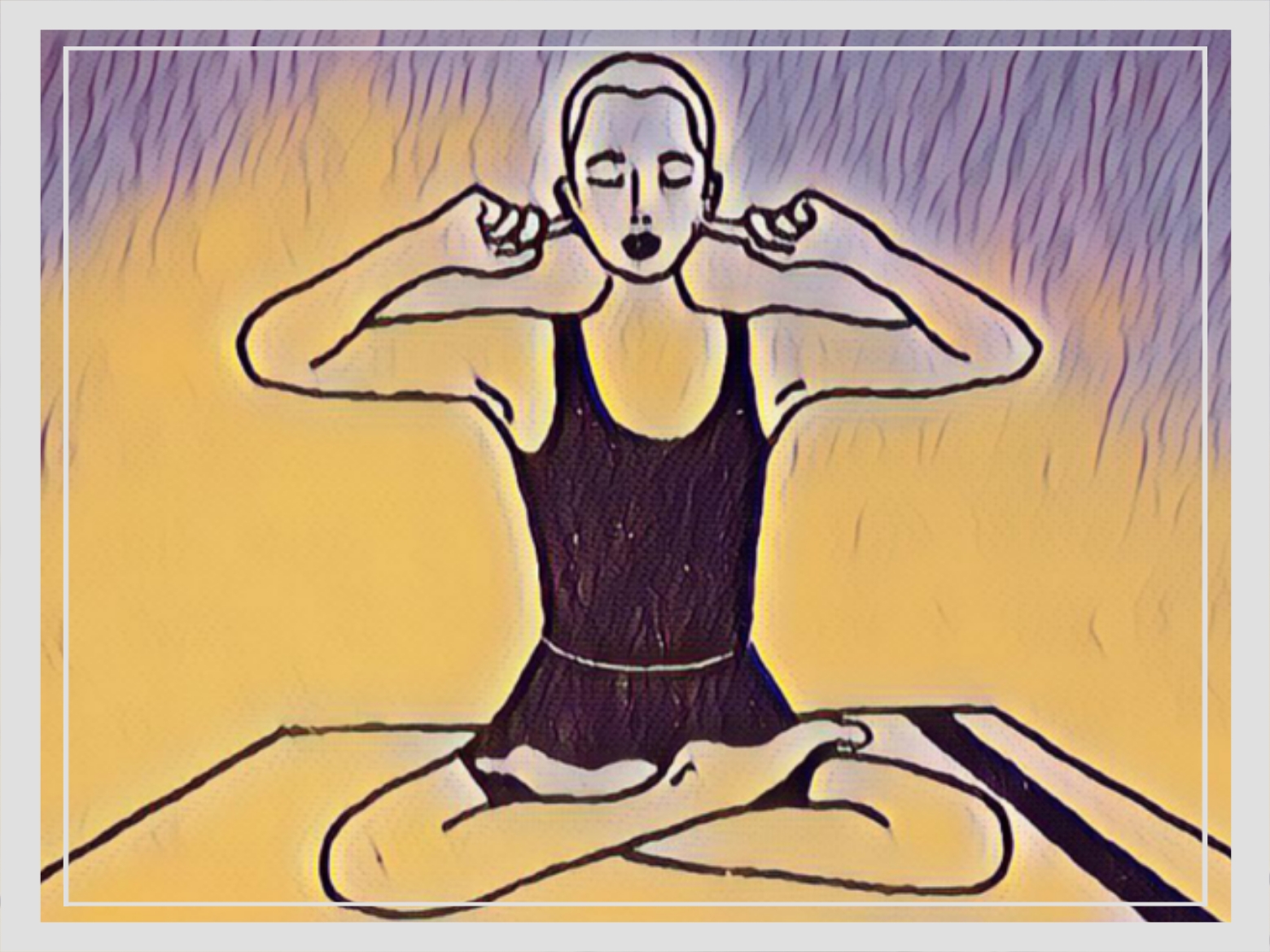What is Bhramari Pranayama?
Bhramar means ‘bumblebee’. This Bhramari Pranayama is called because the sound produced while doing rechaka is as resonant like that of a bumblebee.

Bhramari relieves cerebral stress and distress by eliminating anger, anxiety and insomnia and reducing blood pressure. It increases the speed of healing of body tissues and can be practiced after surgery.
It improves and strengthens the voice and cures throat diseases. This is a pranayama that calms the mind by reducing anxiety, frustration, anger etc.
What is the purpose of Bhramari Pranayama?
Bhramari Pranayama, or the “Bee Breath,” is a breathing technique in yoga. Its purpose is to promote calmness, reduce stress, and improve concentration by producing a humming sound during exhalation, which can have a soothing effect on the nervous system.
How to Do Bhramari Pranayama?
♦ Sit in a comfortable posture for meditation. Keeps the spine and head straight.
♦ Both hands are kept above the knees in Gyan Mudra. The ideal posture for this exercise is Padmasana or Siddhasana.
♦ Raise your arms up to your shoulders and close your ears with your thumbs. Place the first (index) finger on the eyelids, the middle finger (middle finger) on the nostrils, and the ring and pinky fingers on the lips.
♦ Now breathe slowly and fill the lungs deeply.
♦ Now slowly exhale through the larynx, humming like a whirlwind like ‘Hmmmm’.
♦ The voice should be soft and soft, so that the skull becomes resonant.
♦ It is not necessary that the pitch of the sound be high, but it is important that sound waves should be felt in the brain.
♦ This practice is considered best for making the consciousness introvert.
Duration- Initially 5 to 10 repetitions are sufficient. Then gradually increase the duration of practice to 10-15 minutes. If there is excessive mental stress or anxiety, or if you are using it as a healing process, practice for 30 minutes.
Time- The best time to practice is early morning or midnight, because at that time there are very few external sounds that interfere with the inner experience. Practicing at this time awakens spiritual sensitivity. But to remove mental stress, Bhramari can be practiced at any time. The surrounding environment should be calm.
Benefits of Bhramari Pranayama
Stress Reduction: Bhramari Pranayama helps to activate the parasympathetic nervous system, thereby reducing stress levels.
Calming effect: The rhythmic humming sound during practice produces a calming effect on the mind and nervous system.
Better Concentration: Regular practice enhances focus and concentration by promoting a feeling of inner peace.
Relief from Headache: This pranayama can be effective in providing relief from tension headache and migraine by relaxing the mind and reducing stress.
Thyroid stimulation: The vibrations generated during Bhramari Pranayama stimulate the thyroid gland, potentially helping to maintain hormonal balance.
Emotional Balance: By promoting relaxation and mindfulness, it helps achieve emotional balance and stability.
Blood pressure regulation: Calming effects on the nervous system may contribute to maintaining healthy blood pressure levels.
Better Sleep: Adding Bhramari Pranayama to your daily routine can help improve sleep quality by reducing anxiety and promoting relaxation.
What is the effects of Bhramari Pranayama on mental health?
Bhramari Pranayama has a positive effect on mental health by reducing stress, anxiety and promoting relaxation. It promotes overall mental well-being and contributes to a more balanced emotional state.
Precautions for Bhramari Pranayama
Do Bhramari Pranayama on an empty stomach. Keep the following things in mind-
(1) If you feel dizzy or nervous while practicing, stop the practice and start breathing normally.
(2) In traditional Bhramari Pranayama, people make the sound of bhanva while inhaling and exhaling.
(3) Bhramari should not be practiced lying down.
(4) If you have ear infection, do not practice it until the infection goes away.
(5) People suffering from heart disease should do this practice without Kumbhaka.
Frequently Asked Questions
How many minutes should we do Bhramari Pranayama?
Bhramari Pranayama is typically practiced for about 5 to 15 minutes. However, the duration can vary based on individual preferences and comfort levels. It's advisable to start with a shorter duration and gradually increase it as you become more accustomed to the practice.
Who should avoid Bhramari Pranayama?
People experiencing severe ear infections, migraine headaches or high blood pressure should avoid Bhramari Pranayama. Additionally, pregnant women are advised to consult a health care professional before practicing this breathing technique.
How to perform Bhramari Pranayama?
Sit comfortably, close your eyes, and place index fingers on the cartilage between cheek and ear. Inhale, then exhale making a humming sound like a bee. Repeat, focusing on the sound and vibrations.
Can we do Bhramari Pranayama at night?
Yes, Bhramari Pranayama can be done at night and may help promote relaxation and better sleep.
How to do Bhramari Pranayama beginners?
Sit comfortably, close eyes, place fingers on face, inhale, exhale with a humming sound. Repeat for relaxation.
How many rounds of Bhramari Pranayama?
Start with 5 rounds of Bhramari Pranayama and gradually increase as you become more comfortable with the practice. Listen to your body and adjust the number of rounds based on your individual capacity.
What are the benefits of Bhramari Pranayama for anxiety?
Bhramari Pranayama helps reduce anxiety by promoting calmness, calming the nervous system and inducing a relaxation response through controlled breathing and humming vibrations.
Does Bhramari increase concentration?
Yes, Bhramari Pranayam promotes concentration by calming the mind, reducing stress and promoting a focused mental state.
Read Also
- What is Ujjayi Pranayama | Steps | Benefits | Precautions
- How to Do Chandra Bhedana Pranayama and its Benefits
- What are the Benefits of Sheetali Pranayama and Steps
- How to Do Bhastrika pranayama | Steps | Benefits | Precautions
- Benefits of Kapalbhati | Steps | Precautions